Study of 220Rn and its Progeny Circulation in a Test Room
1
Department of Physics,
Government Science College,
Nrupathunga Road, Bangalore,
Karnataka
India
Corresponding author Email: lasgayit@gmail.com
DOI: http://dx.doi.org/10.12944/CWE.18.3.25
Copy the following to cite this article:
Sathish L. A. Study of 220 Rn and its Progeny Circulation in a Test Room. Curr World Environ 2023;18(3). DOI:http://dx.doi.org/10.12944/CWE.18.3.25
Copy the following to cite this URL:
Sathish L. A. Study of 220 Rn and its Progeny Circulation in a Test Room. Curr World Environ 2023;18(3).
Download article (pdf) Citation Manager Publish History
Select type of program for download
| Endnote EndNote format (Mac & Win) | |
| Reference Manager Ris format (Win only) | |
| Procite Ris format (Win only) | |
| Medlars Format | |
| RefWorks Format RefWorks format (Mac & Win) | |
| BibTex Format BibTex format (Mac & Win) |
Article Publishing History
| Received: | 2023-04-02 |
|---|---|
| Accepted: | 2023-10-31 |
| Reviewed by: | 
 Balarak Davoud
Balarak Davoud
|
| Second Review by: |

 Mona Amin
Mona Amin
|
| Final Approval by: | Dr. Gopal Krishan |
Introduction
Since the focus on the health effects of radiation exposure has switched from acute high levels to chronic low levels, both scientists and the general public is becoming more concerned about background radiation1. Due to higher average concentrations of early radionuclides in soil and the byproducts of their decay, such as 222Rn (radon) and 220Rn (thoron), in the surroundings, many places on Earth have higher natural background radiation levels1. The background radiation has recently increased due to the technological advancement of naturally existing radioactive material. It's estimated that inhaling 222Rn, 220Rn, and their temporary offspring contributes over 54 percent of the radiation dose from the ambient environment that the general public encounters2, 3. So, the external component also needed to include an inhaling component. No country has an accurate national estimate for this component as of yet3. The 220Rn issue will also cause issues for businesses who use thorium nitrate3. Thoriated petrol mantle lamps are still used in countries like India for both indoor and outdoor environment, as well as by street vendors in both rural and urban areas3. These businesses handle a lot of thorium nitrate, which means that the amount of 220Rn gas they emit and the offspring they create may both have a considerable impact on the breathing dose of their staff3. It is untrue that large concentrations of 220Rn may be present in living and working environments throughout a wide range of countries, and it is increasingly clear that information on 220Rn in the environment may be required to fully understand inhalation dose4 and the new dose conversion coefficients are available in the literature for the half springs5. As a result, compared to 222Rn6, even small quantity of 220Rn progenies result in a larger radiation dose. As a result, the health sciences community is becoming more interested in 220Rn exposure. Numerous 220Rn surveys were recently conducted in various cities and states reported by several researchers7–11. Additionally, numerous papers12 have argued for the adoption of trustworthy 220Rn measurement methodologies. This paper summarizes the existing situation of 220Rn levels in indoor settings, workplaces, and other substantial amounts of 220Rn. A description of measurement methods and levels reported in the literature is also provided.
Materials and Methods
According to reports, the inhalation pathway is the main source of the radiation dosage that humans receive from natural sources13. Radon and its progeny nuclides are the principal contributors to this route dosage. Thus, measuring the amount of radon in the internal air becomes crucial for assessing the exposure of ambient atmosphere. Because atmospheric radon gases change throughout the day and throughout the seasons, it is crucial to conduct long-term integrated measurements to accurately estimate the gas concentration. For long term measurements cellulose nitrate based dosimeters are used14, 15. The detailed explanations are available in the literature 16, 17. The activity fractions in relation to the parent gas are recovered through ventilation rate18. Working level concentrations and equilibrium factor are estimated through the formulas provided by UNSCEAR5.The calibration facilities, dosimeter standardization, and dosimetry methodology are all covered in depth elsewhere19.
Result and Discussion
On the basis of the material we have read and the data we have collected, we project the findings below. We display the 220Rn readings obtained in a test chamber during a three-year period. All measurements were made on the ground floor. Dosimeters were positioned in lower and upper parabolic arrangements, 60 cm to 450 cm apart from one another, and at equal heights from the floor and the ceiling in the 31 m3 test room.
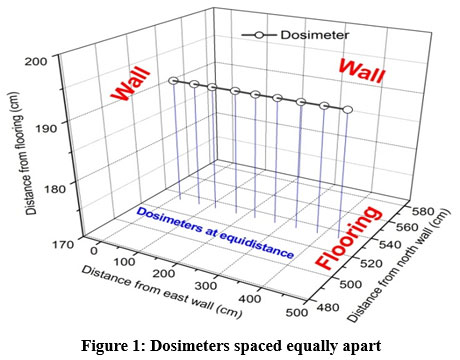 | Figure 1: Dosimeters spaced equally apart
|
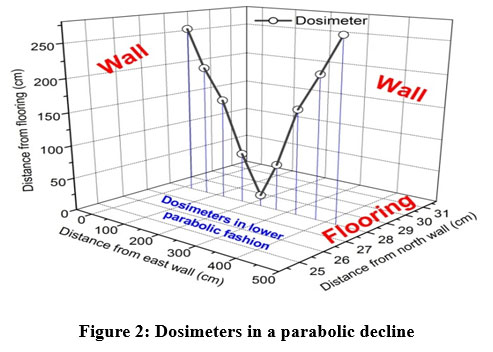 | Figure 2: Dosimeters in a parabolic decline
|
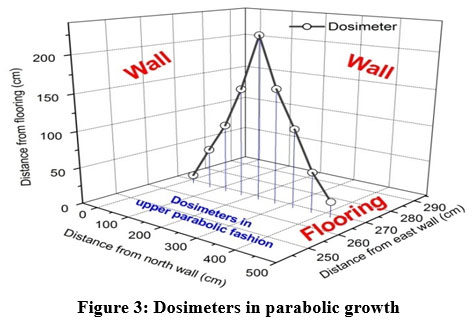 | Figure 3: Dosimeters in parabolic growth
|
Figures 1, 2, and 3 depict the deployment of dosimeters in an equidistant, lower- and upper-parabolic form, respectively. Figure 4 displays the results of the 220Rn concentration measurement with equally spaced wall spacing. In the southern part of India, these measurements are the first of their kind.
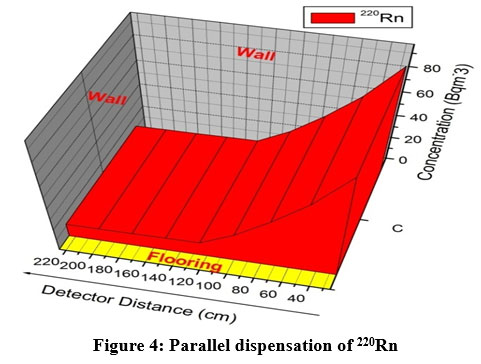 | Figure 4: Parallel dispensation of 220Rn
|
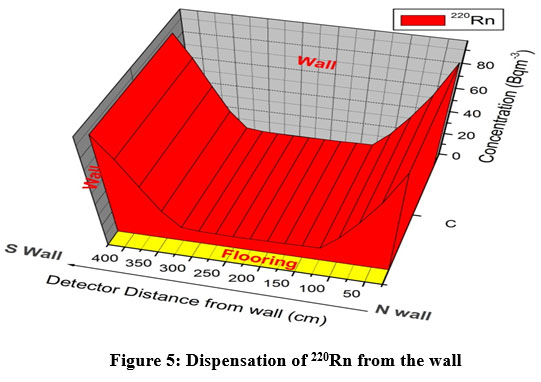 | Figure 5: Dispensation of 220Rn from the wall
|
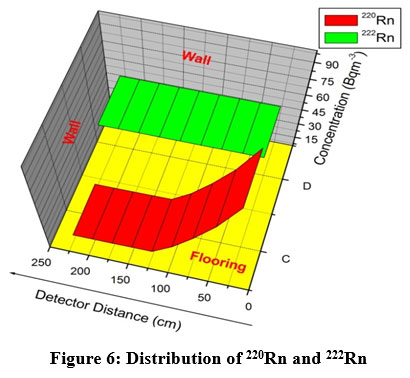 | Figure 6: Distribution of 220Rn and 222Rn
|
The short half-life of this substance may be the reason for the exponential concentration20, 21 drops with distance shown in Figure 4. This suggests that when measuring indoor 220Rn, it's crucial to maintain a safe distance from the wall of the house. As seen in Fig. 5, the effect of distance on concentrations changes when dosimeter is moved away from one point of the wall, like one point of the north wall, and placed closer towards another point of the wall, like one point of the south wall. In order to monitor the simultaneous dispersion of 222Rn and 220Rn concentrations at various distances from walls, ceilings, and floors, twin cup dosimeter measurements were also made. The distribution of 220Rn and 222Rn concentrations within a home is shown in Figure 6. Locally produced bricks were used to build the walls and floors, and it is assumed that the 222Rn and 220Rn in the bricks came from local soil resources. Due to the small time of 220Rn, length of moment needed to transit, as seen in Fig. 6, the concentration is waning towards the centre point of the test room. However, due to longer period of time of 222Rn, the level is constant throughout the entire house. Figure 7 illustrates that the concentration of 220Rn is significantly higher than that of 222Rn near the walls. More wall distance results in more similar concentrations. The 220Rn levels fall below the 222Rn concentration at a distance greater than 20 cm from the wall, but it stands constant. Our findings concur with other researchers' findings22.
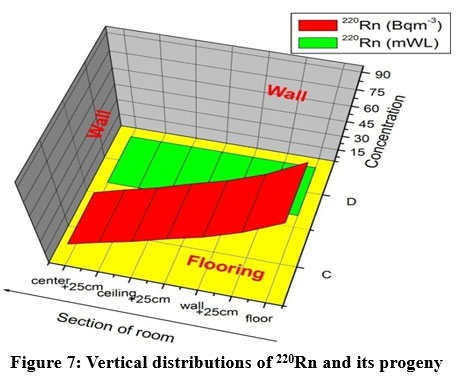 | Figure 7: Vertical distributions of 220Rn and its progeny
|
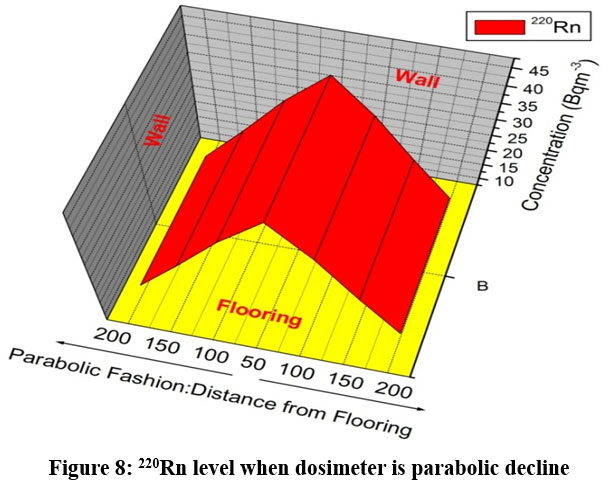 | Figure 8: 220Rn level when dosimeter is parabolic decline
|
Similar findings were also made in a number of homes in the Gansu region, according to Shang et al23, which indicates that 222Rn indoor concentration is generally present. The dramatic increase in concentration close to the wall is shown in Figures 5, 6, and 7. The turbulence flowing from the wall towards the middle of the space diminishes the comparative part of 220Rn levels towards the wall. Only ventilation rates greater than the exhalation saturation of the entire activity are important for occupant dose assessment24. Interior 220Rn concentrations increase as a result of 220Rn-emitting building materials. There is a concentration gradient in the room as a result of the short half-life, with concentrations being greater on the walls, ceiling, and floor.
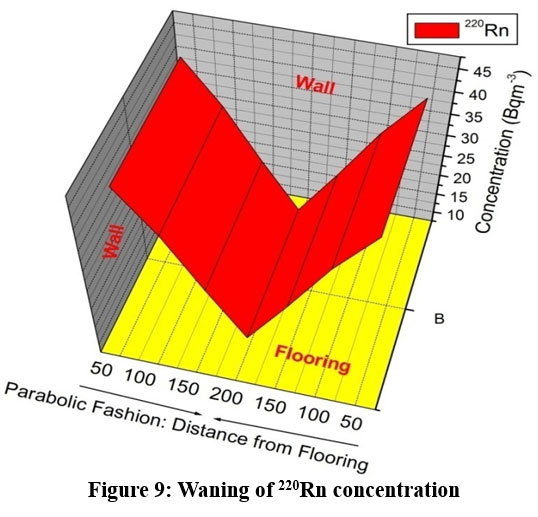 | Figure 9: Waning of 220Rn concentration.
|
Figure 7 shows the progeny concentration and vertical distributions of 220Rn. The concentration of 220Rn decreases rapidly as one gets farther away from the ground. Still, the distance to the wall had little effect on the progeny concentration. Model estimates revealed a potential link between the homogeneity of 220Rn progeny concentrations throughout a residence and their lengthy half-life (10.64 h)20. The modifications are shown in Figs. 8 and 9. The dosimeters were also arranged in parabolic decline and growth configurations to acquire the measurements. Observing the concentrations in relation to the locations of the dosimeters in reverse order is pretty interesting. This might be as a result of the short half-life of 220Rn, which causes the concentrations to reverse as moving the detector away from the floor of the room. The dosimeters were also put in 300 residences over 10 distinct Bangalore neighborhoods over a period of more than ten years. With a mean value of 22.8 Bqm-3 (GM: 18.9) and 0.33 mWL, the observed concentrations of 220Rn and its progeny ranged from 8.4±0.2 to 69.4±3.5 Bqm-3, 0.01 to 6.2 mWL. Smaller houses and houses with granite flooring had higher concentrations, which may be connected to the neighborhood's higher 232Th activity levels25. The authors25 found that 232Th concentrations in 67% of the samples were greater than the 40 Bqkg-1 global norms. The readings for both India as a whole and the rest of the world were comparable to the average concentration of 232Th (53.1 Bqkg-1). The data also showed a definite seasonal fluctuation with a summer minimum and a winter high. The impact of interior ventilation may have an impact on this trend26. Numerous factors, such as the 226Ra and 224Ra present in building materials, the exhalation from walls, and ventilation conditions, have been shown to have an impact on indoor 222Rn and 220Rn concentrations26. The short half life of 220Rn may make exhalation the most important component. Since dirt walls tend to be more porous than other types of building materials, 220Rn diffusion is made simpler26. This might be the reason for the elevated 220Rn content found in brick and earth-walled homes26. For houses based on space, room, season, and wall considerations, the link between 220Rn and its progeny was found to be 0.84, 0.74, 0.85, and 0.75, respectively. A stronger connection of 0.85 was seen in data that were dependent on the season. This can be due to the variable ventilation conditions. Similar findings were observed by Guo et al26, who also reported a correlation coefficient of 0.79 between the levels of 220Rn and its offspring. The frequency distribution of the 220Rn and 220Rn progeny is shown in Figs. 10 and 11, respectively. 90% of 220Rn concentrations fell between 10 and 40 Bqm-3, with 10% of 220Rn concentrations reaching a maximum of 70 Bqm-3. Around 66% of 220Rn progeny concentrations had a minimum of 0.01 mWL, 28% were in the 0.11 to 3 mWL range, and the final 6% were in the 3.1 to 6.2 mWL range.
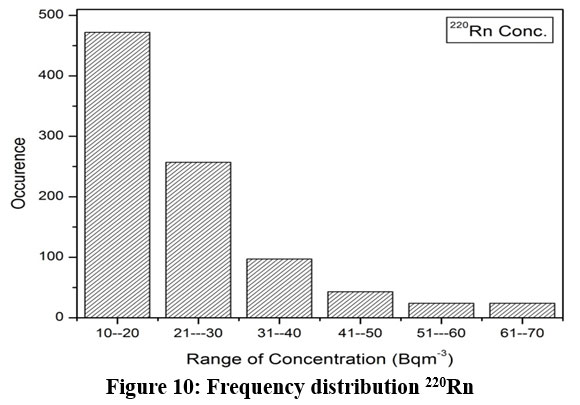 | Figure 10: Frequency distribution 220Rn
|
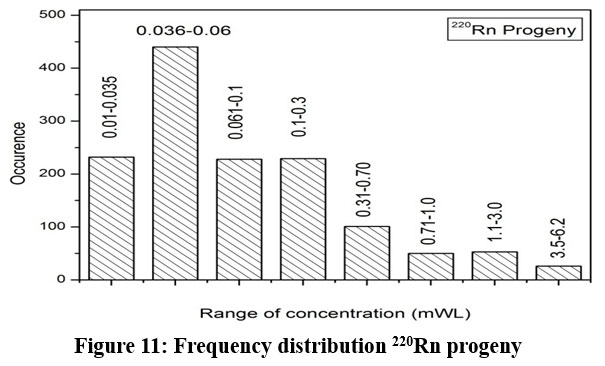 | Figure 11: Frequency distribution 220Rn progeny
|
The average concentrations of 220Rn and its progeny at the observed sites were found to be 22.8 Bqm-3 and 0.33 mWL, respectively. Zhuo et al27 measured the concentrations of 220Rn and its offspring in both indoor and outdoor contexts using the grab sampling approach. 48.1± 20.0 and 22.1±10.7 Bqm-3 were the results, respectively. The average equilibrium-equivalent concentrations for the same environment were 1.13±0.80 and 0.50±0.29 Bqm-3, respectively. For all types of wall construction, homes with soil/mud walls had the greatest 220Rn concentration; the reported average value for this kind of home was 104 Bqm-3. The ratio of exposure to 222Rn, 220Rn, and their offspring to that from 220Rn and its offspring was reported25 to be 30.5% in Guangdong province. Martinez et al28 conducted extensive research on the levels of indoor 220Rn in residences in Mexico City, and the findings revealed a broad log-normal distribution of integrated concentration with annual geometric and arithmetic averages of 82 and 55 Bqm-3, respectively. It deviates by 8 to 234 Bqm-3 from the global average of 3 Bqm-3. The observations made in Bangalore's surroundings have been recorded, and they align with those made elsewhere27–29.
Conclusion
220Rn levels were highest on the walls, ceiling, and floors of the test room and rapidly fell away from them. The concentration of 220Rn offspring indoors is unaffected by the separation between walls. It is essential to analyze public exposure to natural radiation more carefully across the nation, with a focus on 220Rn and its offspring.
Acknowledgments
The cooperation extended by all the Principals and the heads of the departments is acknowledged for allowing us to use the instruments to take the data in the test room.
Conflict of Interest
Author(s) do not have any conflict of interest.
Funding Sources
The author is thankful to the Research Funding Council, University Grants Commission, New Delhi, India for providing the funds to carry out research work.
References
- Burchfield L.A., Akridge J.D., Kuroda P.K. Temporal Distributions of Radio Strontium Isotopes and Radon Daughters in Rain Water during a Thunderstorm. J Geophy Res.1983; 88: 8579 – 8584.
CrossRef - United Nations Scientific Committee on the Effects of Atomic Radiation, (2019) sources, Effects and Risk of Ionization, Report to the General Assembly, Scientific Annexes B: Lung Cancer from exposure to Radon, 195.
- Ramola R.C., Mukesh Prasad, Tushar Kandari, Preeti Pant, Peter Bossew. Rosaline Mishra, Tokonami S. Dose estimation derived from the exposure to radon, thoron and their progeny in the indoor environment, Scientific Reports. 2016; 6: 31061.
CrossRef - Ramachandran T.V., and Sathish L.A. 220Rn in indoor Environment of India: A Review. Uni J Env ResTech. 2011; 1: 7-21.
- International Commission on Radiological Protection . Annals of the ICRP 46 (3/4) ICRP Publication 137; London, UK: 2017. Occupational intakes of radionuclides: Part 3. [Google Scholar]
CrossRef - Tokonami S. Characteristic of Thoron (220Rn) and its progeny in the indoor environment. Int. J. Environ. Res. Public Health. 2020;17:8769. doi: 10.3390/ijerph17238769. [PMC free article] [PubMed] [CrossRef] [Google Scholar]
CrossRef - Bineng G.S., Saïdou S.T., Hosoda M., Siaka Y.F., Issa H., Suzuki T., Kudo H., Bouba O. The importance of direct progeny measurements for correct estimation of effective dose due to radon and thoron. Front. Public Health. 2020;8:17. doi: 10.3389/fpubh.2020.00017. [PMC free article] [PubMed] [CrossRef] [Google Scholar]
CrossRef - Omori Y., Tokonami S., Sahoo S.K., Ishikawa T., Sorimachi A., Hosoda M., Kudo H., Pornnumpa C., Nair R.R.K., Jayalekshmi P.A., et al. Radiation dose due to radon and thoron progeny inhalation in high-level natural radiation areas of Kerala, India. J. Radiol. Prot. 2017;37:111–126. doi: 10.1088/1361-6498/37/1/111. [PubMed] [CrossRef] [Google Scholar]
CrossRef - Nyambura C., Tokonami S., Hashim N.O., Chege M.W., Suzuki T., Hosoda M. Annual effective dose assessment due to radon and thoron progenies in dwellings of Kilimanbogo, Kenya. Radiat. Prot. Dosim. 2019;184:430–434. doi: 10.1093/rpd/ncz090. [PubMed] [CrossRef] [Google Scholar]
CrossRef - Smetsers R.C.G.M., Blaauboer R.O., Dekkers F., Slaper H. Radon and thoron progeny in Dutch dwellings. Radiat. Prot. Dosim. 2018;181:11–14. doi: 10.1093/rpd/ncy093. [PubMed] [CrossRef] [Google Scholar]
CrossRef - Saputra M.A., Nugraha E.D., Purwanti T., Arifianto R., Laksmana R.I., Hutabarat R.P., Hosoda M., Tokonami S. Exposures from radon, thoron, and thoron progeny in high background radiation area in Takandeang, Mamuju, Indonesia. Nukleonika. 2020;65:89–94. doi: 10.2478/nuka-2020-0013. [CrossRef] [Google Scholar]
CrossRef - Hosoda M., Kudo H., Iwaoka K., Yamada R., Suzuki T., Tamakuma Y., Tokonami S. Characteristic of thoron (220Rn) in environment. Appl. Radiat. Isot. 2017;120:7–10. doi: 10.1016/j.apradiso.2016.11.014. [PubMed] [CrossRef] [Google Scholar]
CrossRef - UNSCEAR (2000) United Nations Scientific Committee on the Effects of Atomic Radiation, Sources, Effects and Risks of Ionizing Radiation, Report to the General Assembly, (United Nations,New York).
- Fleischer, R.L., (1988) Radon in the environment-Opportunities and hazard, Nucl Trac Rad Meas. 14: 421-435.
CrossRef - Ilic R., and Sutej T.,(1977) Radon Monitoring devices based on Etched Track Detectors, In: 222Rn Measurements by Etched Track Detectors, Applications in Radiation Protection, EarthSciences and the Environment, (Eds., S.A. Durrani.and R. Ilic), World Scientific, (Singapore), 103-128.
CrossRef - Ramachandan T.V., and Sathish L.A., (2011a) 220-Rn in the indoor environment and work places: a review: Proceedings of the 2011 AARST International Symposium, Vol 1, 9-10. October, 2011
- Miles J.C.H., Calibration and standardization of etched track detectors in Radon measurements by etched track detectors, applications in radiation protection, Earth Sciences and the Environment (Eds, Durrani, S.A., and Ilic, R) World Scientific, (Singapore), 1997; 43-176.
CrossRef - Mayya Y.S., Eappen K.P., Nambi K.S.V., Methodology for mixed field inhalation dosimetry in monazite areas using a twin cup dosimeter with three track detectors. Rad Prot Dosim. 1998; 77: 177-184.
CrossRef - Ramachandan T.V., and Sathish L.A., Nationwide indoor 222Rn and 220Rn map for India: a review. J of Environ Radio act. 2011; 102(11): 975-986. Doi:https://doi.org/10.1016/j.jenvrad.2011.06.009
CrossRef - Tso M.W., Li C. Indoor and Outdoor 222Rn and 220Rn Daughters in Hong Kong. Healt Phys. 1987; 53: 175–180.
CrossRef - Yamasaki T., Guo Q., Iida T. Distributions of thoron progeny concentrations in Dwellings. Rad Prot Dosi. 1995; 59(2): 135–140.
CrossRef - Tetsuya S., Measurement of Indoor Thoron Gas Concentrations Using a Radon-Thoron Discriminative Passive Type Monitor: Nationwide Survey in Japan. Int J Environ Res Pub Healt. 2021; 18(3): 1299.
CrossRef - Shang B., Chen B., Gao Y., Wang Y., Cui H., Zhou Li. Thoron levels in traditional Chinese residential dwellings. Rad Environ Biophy. 2005; 44: 193–199.
CrossRef - Tschiersch J., Li W.B., Meisenberg O. Increased 220Rn indoor concentrations and implication to inhalation Dosimetry. Rad Prot Dosi. 2007; 127: 73-78.
CrossRef - Shiva Prasad N.G., Nagaiah N., Ashok G.V., Karunakara N. Concentrations of 226Ra, 232Th, and 40K in the soil of Bangalore region, India. Healt Phys. 2008; 94: 264- 271.
CrossRef - Guo Q., Iida T., Okamoto K. Measurements of Thoron Concentration by Passive Cup Method and Its Application to Dose Assessment. J Nucl Sci Tech. 1995; 32: 794-803.
CrossRef - Zhuo W., Iida T., Yang X. Environmental Radon and Thoron Progeny Concentrations in Fujan Province of China. Rad Prot Dosi. 2000; 87: 137–140.
CrossRef - Martinez T., Navarrete M., Gonzalez P., Ramirez A. Variation in indoor thoron levels in Mexico City Dwellings. Rad Prot Dosi. 2004; 111: 111–113.
CrossRef - Rishi Pal C., Amit K., Neetika C., Distribution of indoor thoron in dwellings under normal and turbulent flow conditions using CFD simulation technique. Nucl Tech & Rad Prot. 2017; 32(2):180-184.
CrossRef







